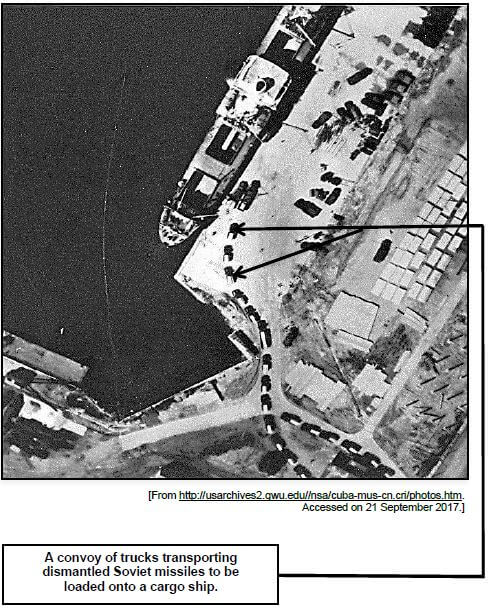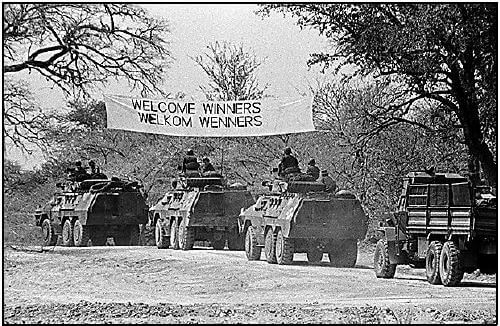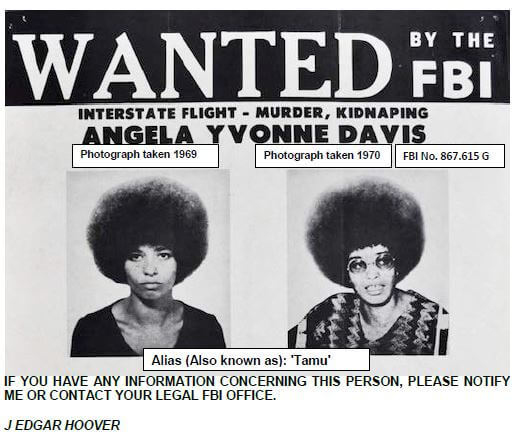HISTORY PAPER 1 GRADE 12 ADDENDUM - NSC EXAMS PAST PAPERS AND MEMOS NOVEMBER 2018
Share via Whatsapp Join our WhatsApp Group Join our Telegram GroupHISTORY
PAPER 1
GRADE 12
NSC EXAMS
PAST PAPERS AND MEMOS NOVEMBER 2018
ADDENDUM
QUESTION 1: HOW DID THE SOVIET UNION AND THE UNITED STATES OF AMERICA RESPOND TO THE DEPLOYMENT OF MISSILES TO CUBA IN 1962?
SOURCE 1A
The source below explains how President JF Kennedy and President N Khrushchev reacted to the deployment of missiles in Cuba.
President Kennedy summoned a crisis management team, the Executive Committee (ExComm), to deal with the threat of missiles in Cuba. Kennedy rejected calls from the military for an immediate air strike followed by an invasion of Cuba and ordered instead a naval quarantine (blockade) of the island. Khrushchev ignored the quarantine and Soviet ships containing missiles headed for Cuba. However, on 24 October, six Soviet ships turned back towards the Soviet Union. At this point Dean Rusk, the US Secretary of State, commented, 'We're eyeball to eyeball and I think the other fellow just blinked.' Nevertheless, the crisis continued as the missile sites still remained in Cuba. [From History 20th Century World, The Cold War by K Rogers and J Thomas] |
SOURCE 1B
The source below is part of a speech that President Khrushchev delivered on Radio Moscow on 27 October 1962. It focuses on his decision to remove Soviet missiles from Cuba.
I therefore make this proposal: We are willing to remove the missiles from Cuba which you regard as offensive. We are willing to carry this out and to make this pledge (promise) to the United Nations. Your representatives will make a declaration to the effect that the United States, for its part, considering the uneasiness and anxiety of the Soviet State, will remove similar missiles from Turkey. These are my proposals, Mr President. [From https://www.marxistorg/archive/khrushchev/1962/10/27.htm. Accessed on 20 September 2017.] |
SOURCE 1C
The aerial photograph below shows a convoy of trucks transporting the dismantled Soviet missiles to a cargo ship that was docked at Port of Mariel, Cuba, in November 1962. 
[From http://usarchives2.gwu.edu//nsa/cuba-mus-cn.cri/photos.htm. Accessed on 21 September 2017.]
SOURCE 1D
The following is part of a speech that JF Kennedy, the President of the United States of America (USA), delivered from the White House on 2 November 1962. It focuses on the removal of Soviet missiles from Cuba.
My fellow citizens: I want to take this opportunity to report on the conclusions which this government has reached on the basis of yesterday's aerial photographs, which will be made available tomorrow, as well as other indications, namely that the Soviet missile bases in Cuba are being dismantled, their missiles and related equipment are being crated (put in boxes), and the fixed installations at these sites are being destroyed. [From Thirteen Days: A Memoir of the Cuban Missile Crisis by RF Kennedy] |
QUESTION 2: WHAT ROLE DID FOREIGN POWERS PLAY IN THE BATTLE OF CUITO CUANAVALE?
SOURCE 2A
The source below focuses on the reasons for South Africa's involvement in the Cold War in Angola.
John Vorster (South Africa's Prime Minister) placed the blame for South Africa's intervention in Angola squarely on the shoulders of Russia and Cuba: 'Our involvement was the effect of Russian and Cuban intervention. If they did not enter Angola, if they did not take part in this affair, if they did not try to subvert (undermine) the whole of Angola and to suppress (contain) its people, South Africa would never have entered Angola at all … We went in to chase Cuba and the MPLA away from the dams (Ruacana and Calueque)'. [From South Africa in the 20th Century by BJ Liebenberg and SB Spies (editors)] |
SOURCE 2B
The extract below focuses on the involvement of Angola, Cuba, South Africa and Russia in the Battle of Cuito Cuanavale.
In August 1987 Angolan and Cuban brigades (units of soldiers) under a Russian commander began a large-scale attack on UNITA. The South African troops who were rushed to the rescue made use of tanks for the first time since World War II. The fighting that raged in Cuito Cuanavale has been called the greatest battle to date in Africa south of the Sahara. The South Africans, supported by UNITA, halted the Angolans' advance on the Lomba River and then drove them back towards Cuito Cuanavale, where the Angolan soldiers dug in and resisted obstinately (stubbornly). They also began to get increasing support from their air force while the South African air force began to lose air control. The Chief of the South African Defence Force (SADF) thought that Cuito Cuanavale could be taken, but that it would cost the lives of about 300 white soldiers as well as a great number of black soldiers from the South West African Territorial Force and UNITA. Such a price was regarded as too high and it was decided to leave Cuito Cuanavale in Angolan possession … [From http://www.defenceweb.co.za/index.php?option=com_content&view=article&id=51193. Accessed on 18 April 2018.] |
SOURCE 2C
The photograph below shows a convoy of South African Defence Force military vehicles leaving Angola and entering Namibia in 1988. 
[From https://www.historytoday.com/gary-baines/replaying-cuito-cuanavale. Accessed on 18 April 2018.]
SOURCE 2D
This extract was taken from a speech that was delivered by Rodolfo Benítez Verson, the Cuban ambassador in South Africa, on 23 March 1988. He outlines how Cuba won the Battle of Cuito Cuanavale.
On 23 March 1988, the South Africans and the puppet armed group, National Union for the Total Independence of Angola (UNITA), supported by the United States of America, launched their last major assault on Cuito Cuanavale. [From https://www.iol.co.za/capetimes/opinion/cuito-cuanavale-the-turning-point-14003886. Accessed on 18 April 2018.] |
QUESTION 3: WHAT INFLUENCE DID THE PHILOSOPHY OF BLACK POWER HAVE ON AFRICAN AMERICANS IN THE 1960s AND 1970s?
SOURCE 3A
The source below explains the role that television played in motivating young African Americans to be proud of their black identity.
Televised coverage of the movement heightened the importance of an embodied (in person) image of black militancy. Emory Douglas, who became minister of culture of the Black Panther Party, described how his thinking was shaped by this medium: 'I was very inspired by Stokely [Carmichael] and Rap [H Rap Brown]. I used to see them on TV all the time. And they were fearless in that time. I identified with them. [Stokely] was talking about Black Pride and Black Power.' Pearl Marsh, who at the time was a student at a historically black college, decided to stop straightening her hair after seeing militants on television. In these militants she saw something that seemed to be her authentic (real) self. [From Ain't I a Beauty Queen? Black Women, Beauty, and the Politics of Race by ML Craig] |
SOURCE 3B
The source below focuses on the role that Angela Davis played in the struggle against oppression in the United States of America in the 1960s and 1970s.
Angela Davis, activist, educator, scholar and politician lived in the 'Dynamite Hill' area of Birmingham, Alabama. The area received that name because so many African American homes in this middle-class neighbourhood had been bombed over the years by the Ku Klux Klan. [From http://www.blackpast.org/aah/davis-angela-1944-0. Accessed on 18 April 2018.] |
SOURCE 3C
The poster below was prepared and distributed by the Federal Bureau of Investigation (FBI) in August 1970. It appealed to the public to assist in the arrest of Angela Davis who was on the FBI's most wanted list of fugitives (run-aways).
 [From https://www.history.com_Angela_Davis. Accessed on 21 March 2018.] |
SOURCE 3D
The source below focuses on the statement that Edgar Hoover (FBI director) issued regarding the Black Panther Party. It was published in the Desert Sun, a Californian newspaper, on 16 July 1969.
BLACK PANTHER GREATEST THREAT TO US SECURITY WASHINGTON: … Hoover said in his fiscal (financial) 1969 annual report the increased activity of 'violence-prone black extremists groups' had put more investigative responsibilities on the FBI. 'Of these,' Hoover said, 'the Black Panther Party, without question, represents the greatest threat to the internal security of the country. Schooled in the Marxist-Leninist ideology and the teachings of Chinese Communist leader, Mao ZeDong, its members have perpetrated (done) numerous assaults on police officers, destroyed public property and have engaged in violent confrontations with police in cities throughout the country.' Hoover said, 'Leaders and representatives of the Black Panther Party travel extensively all over the United States preaching their gospel of hate and violence not only to ghetto residents, but also to students in colleges, universities and high schools as well.' [From https://cdnc.ucr.edu/cgi-bin/cdnc?a=d&d=DS19690716.2.89. Accessed on 17 March 2018.] |
ACKNOWLEDGEMENTS
Visual sources and other historical evidence were taken from the following:
Craig, ML. 2002. Ain't I a Beauty Queen? Black Women, Beauty, and the Politics of Race (Oxford University Press, New York)
http://usarchives2.gwu.edu//nsa/cuba-mus-cn.cri/photos.htm
http://www.blackpast.org/aah/davis-angela-1944-0
http://www.defenceweb.co.za/index.php?option=com_content&view=article&id=51193 https://cdnc.ucr.edu/cgi-bin/cdnc?a=d&d=DS19690716.2.89
https://www.history.com_Angela_Davis
https://www.historytoday.com/gary-baines/replaying-cuito-cuanavale
https://www.iol.co.za/capetimes/opinion/cuito-cuanavale-the-turning-point-14003886
https://www.marxistorg/archive/khrushchev/1962/10/27.htm
Kennedy, RF. 1971. Thirteen Days: A Memoir of the Cuban Missile Crisis (WW Norton & Company, New York)
Liebenberg, BJ and Spies, SB (eds). 1993. South Africa in the 20th Century (JL Van Schaik, Pretoria)
Rogers, K and Thomas, J. 2008. History 20th Century World, the Cold War (Pearson, Essex)